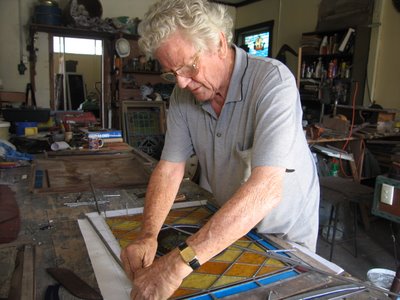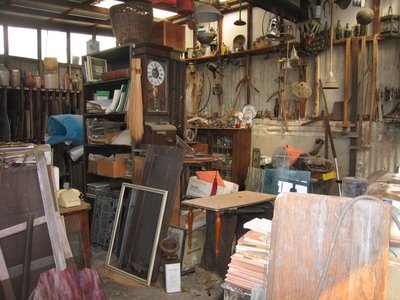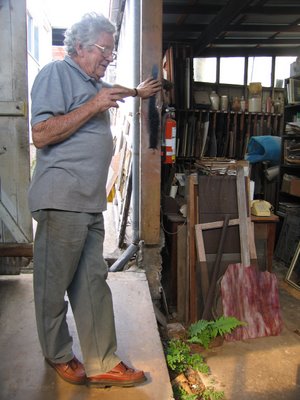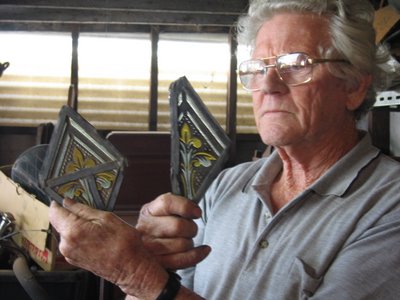








Almost the first words Kevin Little said to me when I wandered into his workshop to ask him if I could take a photo of him at work were “I’ve been here for a long time, but not for much longer”.
Kevin is 75, and, one of, if not the most pre-eminent Australian stained glass artists. His workshop is right near where I live.In its heydey, Kevin's business employed 30 artisans here and throughout country areas. But, he told me, "There’s not much of a living to be made any more from being a stained glass artist. “The Protestant churches don’t put in stained glass windows any more, and the almighty dollar rules everything. Even restoration jobs are done on the cheap these days” he said. Kevin also lamented the destruction of much of the stained glass in churches and houses as newcomers rip them out. [I'm pleased to say that we had Kevin repair one in our house when it was damaged a few years back.]
As well as work in glass, Kevin also restores furniture and all manner of things including a gorgeous grandfather clock he found in pieces in a kerbside junkout. He collects an array of things too vast to describe, and his studio/workshop is a veritable museum. Every object has a story, and the connections they weave between people are amazing.Kevin took me on a tour of his world, and I especially loved seeing a couple of fragments of 14th century stained glass, and the “sweatshop” end of the studio, where Kevin showed me the traditional method of drawing a design in chalk, before tracing it on to paper.This is true artisanship, which is not going to be there for much longer.
Kevin has had commissions from many of the leading institutions in Sydney, including Sydney Hospital, the Town Hall and St Mary’s Cathedral.
From A Village Called Arncliffe by R.W. Rathbone. (Wild and Woolley, 1997)
"David McColl Little migrated to Australia from Scotland in the 1870s. Although a butcher by trade, he became interested in the art of leadlighting and eventually obtained a position with Lyon and Cottiers the leading leadlight manufacturers and stained glass artists of their day.In1906 he moved to Arncliffe and opened his own business in Barden Street where he employed his ten children in the trade. Such was the quality of his work that he was soon receiving commissions from churches, public buildings, private homes, shop fronts and the furniture trade.When building activity declined during the Depression, he concentrated simply on glazing to see him through and as leadlighting faded from favour during the thirties and forties the process almost became a lost art.In 1944, David Little died and his business was taken over by his son, William, who, anxious to ensure that the craft did not die out, apprenticed his son Kevin to the trade.Kevin studied art at the East Sydney Technical College before succeeding his father as proprietor of the enterprise in 1956. He specialized in the restoration of ecclesiastical stained glass doing work all over Australia, New Zealand and Canada.With the upsurge of interest in restoring Victorian, Federation and Art deco houses, Kevin Little is recognized as one of the most skilled exponents of the art of leadlighting and stained glass artistry in Australia. He carries out work for the Heritage Commission, the National Trust and the Department of Public Works.H not only restores and repairs existing windows but designs memorial and heraldic windows as well. He has recently been retained to restore the windows of St Mary’s Cathedral in Sydney while his windows for the new St Matthew’s Anglican Church at Albury have been nominated for inclusion in the National Estate. "

8 comments:
Great series of photos Sally and a lovely story too.
Loved this way of covering the topic and recording the artisan. I had similar ideas in mind and have snaps of some local new windows.
What a lovely article! How sad it is that we are losing these valuable trades and leadlights being ripped out of the old buildings to be replaced with tacky modern concrete and glass jungle. His workshop and workmanship is a wonderful reflection of all things wonderful from past years.
A great deal of long lasting beauty is being lost at the expense of short term consumerism and as a leadlighter I agree with him- there is not much of a living to be made with the "almighty dollar ruling everything" to quote him. ( Cheap Asian imports,push for artificial leadlight and request for " freebies and quick cheap repairs"). While people have no qualms about spending hundreds or even thousands of dollars on items that have far less longevity and are of less artistic beauty, we seem to have lost much of excellent craftsmanship and artisans. The culture of " leadlight courses as a hobby and DIY projects" rather than it being viewed as a trade also seems to be a changing culture.
As an member of the teaching fraternity for many years and now a leadlighter(albeit no where near Kevin's knowledge, talent or experience I must say) struggling to make a living I read your article with great interest especially the history of the family's involvement,how it evolved as a family business for so many years and the changing faces of leadlight through the decades. Let's hope there is a revival of interest but moreso that the knowledge is not lost forever.
Sally, my wife and I will be visiting Paris in September. Is there any way we can get in touch with Kevin. I would very much like to visit his studio. Thanks.
zig, http://zeiglerglass.com zigzeigler@copper.net
Hi zigngeorgia
Kevin (and I) live in Sydney, not PAris, so I think that may be a little hard!
Sally
Hmmmm. Obviously geography is NOT my strong suit :) Maybe we'll make it to Sydney some day. zig
This one was beautiful....thanks for it.
www.onlineuniversalwork.com
Late last year Kevin hosted a tour of his workshop, of which I took a series of photographs to share. I am currently working on a heritage building at Parramatta that suffered a fire back in 2012, with damage to lead light windows, of which Kevin was recommended for the project by the heritage architect, unbeknown to me, as I had suggested him as well.Please go to my flickr site at https://www.flickr.com/photos/ben_talman/sets/72157649400949951/ to see this set of images from this amazing piece of local history.
Post a Comment